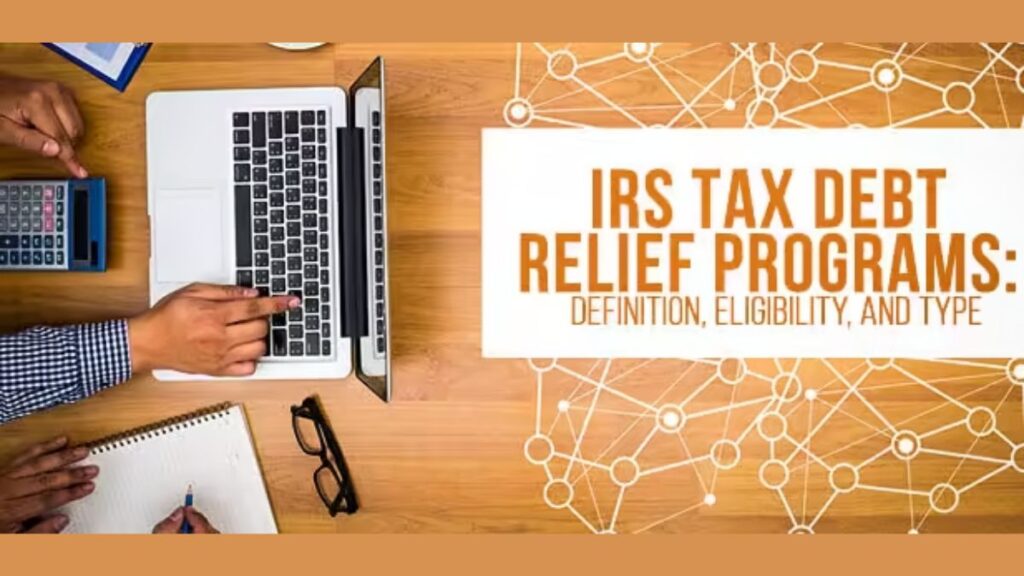Introduction
Tax debt can be a significant burden, causing stress and anxiety for individuals and businesses alike. Fortunately, the IRS offers various programs to help taxpayers manage and alleviate their tax debt. One such program is the IRS Tax Debt Relief Program, which provides avenues for negotiation, settlement, and resolution of tax liabilities. In this comprehensive guide, we will delve into the intricacies of the IRS Tax Debt Relief Program, offering insights, strategies, and practical steps to help you navigate through your tax debt and achieve financial freedom.
Understanding Tax Debt Relief
What is the IRS Tax Debt Relief Program?
The IRS Tax Debt Relief Program is a collection of initiatives designed to assist taxpayers who are struggling with their tax obligations. These programs aim to provide relief by offering options for settling tax debts, reducing penalties and interest, and establishing manageable payment plans.
The Importance of Seeking Tax Debt Relief
Seeking tax debt relief is crucial for individuals and businesses facing financial hardship due to outstanding tax liabilities. Failure to address tax debt promptly can lead to severe consequences, such as wage garnishment, bank levies, and property seizures. By engaging with the IRS Tax Debt Relief Program, taxpayers can mitigate the impact of tax debt and regain control of their financial situation.
Eligibility Criteria
Determining Eligibility for Tax Debt Relief
Eligibility for tax debt relief programs varies depending on factors such as the amount of tax owed, financial hardship, and compliance with tax laws. Generally, taxpayers must demonstrate genuine financial hardship and an inability to pay their tax debt in full to qualify for relief.
Types of Tax Debt Relief Programs
The IRS offers several options for tax debt relief, including:
- Offer in Compromise (OIC): Allows taxpayers to settle their tax debt for less than the full amount owed, based on their ability to pay.
- Installment Agreements: Enables taxpayers to pay their tax debt in monthly installments over an extended period, making it more manageable.
- Currently Not Collectible (CNC) Status: Grants temporary relief from collection activities for taxpayers who are unable to pay their tax debt due to financial hardship.
- Innocent Spouse Relief: Provides relief for taxpayers who are held responsible for a spouse’s tax debt incurred during the marriage.
Exploring Your Options
Offer in Compromise (OIC)
An Offer in Compromise (OIC) is a viable option for taxpayers who are unable to pay their tax debt in full. To qualify for an OIC, taxpayers must demonstrate that paying the full amount of tax debt would cause financial hardship or be inequitable. The IRS considers factors such as income, expenses, assets, and future earning potential when evaluating OIC applications.
Installment Agreements
Installment agreements allow taxpayers to pay their tax debt over time through monthly installments. The IRS offers various installment agreement options, including streamlined agreements for taxpayers with debts below a certain threshold and partial payment installment agreements for those unable to pay the full amount owed.
Currently Not Collectible (CNC) Status
Taxpayers experiencing financial hardship may qualify for Currently Not Collectible (CNC) status, which temporarily suspends collection activities by the IRS. To qualify for CNC status, taxpayers must demonstrate that paying their tax debt would result in significant financial hardship, such as the inability to afford basic living expenses.
Innocent Spouse Relief
Innocent Spouse Relief provides relief for taxpayers who are held liable for a spouse’s tax debt incurred during the marriage. To qualify for innocent spouse relief, taxpayers must meet certain criteria, such as proving that they were unaware of their spouse’s tax obligations or that it would be unfair to hold them responsible for the debt.
Tax Debt Relief: What Every Small Business Owner Should Know
Navigating the Application Process
Gathering Necessary Documentation
Applying for tax debt relief requires thorough documentation of financial information, including income, expenses, assets, and liabilities. Taxpayers must gather supporting documents such as tax returns, bank statements, pay stubs, and expense records to substantiate their financial hardship and inability to pay their tax debt.
Completing the Application
The application process for tax debt relief programs varies depending on the type of relief sought. Taxpayers must carefully review the application requirements and provide accurate and complete information to avoid delays or denials.
Submitting the Application to the IRS
Once the application is complete, taxpayers must submit it to the IRS for review. The IRS will evaluate the application, assess the taxpayer’s eligibility for relief, and determine the appropriate course of action based on the taxpayer’s financial circumstances.
Working with Tax Professionals
Benefits of Hiring a Tax Professional
Navigating the IRS Tax Debt Relief Program can be complex, requiring an understanding of tax laws, regulations, and procedures. Hiring a qualified tax professional, such as a certified public accountant (CPA) or enrolled agent (EA), can help taxpayers navigate the process more effectively and increase their chances of obtaining favorable outcomes.
Choosing the Right Tax Professional
When selecting a tax professional, taxpayers should consider factors such as experience, credentials, reputation, and fees. It’s essential to choose a tax professional with expertise in tax debt relief and a track record of success in helping clients resolve their tax issues.
Maintaining Compliance
Adhering to Payment Plans
Taxpayers approved for installment agreements or other payment arrangements must adhere to the terms of the agreement to avoid default. Failure to make timely payments or comply with IRS requirements could result in the termination of the agreement and reinstatement of collection activities.
Staying Informed About Tax Regulations
Tax laws and regulations are subject to change, and taxpayers must stay informed about updates that may affect their tax debt relief options. Consulting with a tax professional regularly can help taxpayers stay abreast of changes and make informed decisions regarding their tax obligations.
How High Rents Are Pushing Small Businesses to Loan Programs
Avoiding Common Pitfalls
Failing to File Tax Returns
Failing to file tax returns can exacerbate tax debt issues and lead to additional penalties and interest charges. Taxpayers must fulfill their filing obligations promptly and accurately to avoid compounding their tax debt.
Ignoring IRS Notices
Ignoring IRS notices or correspondence regarding tax debt can result in serious consequences, including wage garnishment, bank levies, and property seizures. Taxpayers must address IRS communications promptly and seek assistance if they are unsure how to respond.
Defaulting on Payment Plans
Defaulting on installment agreements or other payment plans can jeopardize taxpayers’ efforts to resolve their tax debt. It’s essential to prioritize tax payments and fulfill obligations under the terms of the agreement to maintain compliance and avoid adverse consequences.
Staying Financially Empowered
Budgeting Strategies
Developing a budget and managing expenses effectively can help taxpayers regain control of their finances and allocate resources toward paying off tax debt. Budgeting tools and strategies, such as tracking expenses, prioritizing debt payments, and cutting discretionary spending, can empower taxpayers to make meaningful progress toward financial stability.
Financial Planning for the Future
In addition to addressing current tax debt issues, taxpayers should focus on long-term financial planning to prevent future tax problems. This may include establishing emergency savings, investing in retirement accounts, and seeking professional financial advice to achieve financial goals and mitigate financial risks.
The Ultimate Guide to Tax Solutions: Everything You Need to Know
Case Studies and Success Stories
Real-Life Examples of Tax Debt Relief
Examining real-life examples of taxpayers who have successfully navigated the IRS Tax Debt Relief Program can provide valuable insights and inspiration for individuals facing similar challenges. Case studies and success stories highlight strategies, pitfalls to avoid, and the potential outcomes of pursuing tax debt relief options.
Testimonials from Individuals Who Have Benefited
Testimonials from individuals who have benefited from tax debt relief programs can offer encouragement and reassurance to taxpayers considering their options. Hearing firsthand accounts of how tax debt relief has improved financial situations and alleviated stress can motivate individuals to take action and seek assistance from the IRS.
Conclusion
Navigating the IRS Tax Debt Relief Program requires patience, diligence, and a proactive approach. By understanding the eligibility criteria, exploring available options, and staying compliant, taxpayers can pave the way toward financial freedom and alleviate the burden of tax debt. Seeking assistance from qualified tax professionals, staying informed about tax regulations, and adopting sound financial management practices are essential steps toward achieving long-term financial stability and peace of mind.
FAQs
How long does it take to receive approval for tax debt relief?
The timeframe for receiving approval for tax debt relief varies depending on factors such as the type of relief sought, the complexity of the case, and the responsiveness of the taxpayer. In general, the IRS aims to process applications for tax debt relief as efficiently as possible, but the timeline can range from several weeks to several months.
Can I negotiate with the IRS directly for debt relief?
Yes, taxpayers can negotiate directly with the IRS for debt relief through various programs such as Offer in Compromise, installment agreements, and Currently Not Collectible status. However, navigating the negotiation process can be complex, and seeking assistance from a qualified tax professional is recommended to ensure the best possible outcome.
What happens if I default on my payment plan?
If you default on your payment plan with the IRS, there can be serious consequences, including the termination of the agreement, reinstatement of collection activities, and additional penalties and interest charges. It’s essential to communicate with the IRS promptly if you are experiencing financial hardship or unable to fulfill the terms of your payment plan to explore alternative options.
Are there any alternatives to the IRS Tax Debt Relief Program?
While the IRS Tax Debt Relief Program offers various options for managing tax debt, there may be alternative solutions available depending on your specific financial circumstances. These alternatives may include seeking assistance from a credit counseling agency, exploring debt consolidation options, or pursuing bankruptcy as a last resort. It’s important to weigh the pros and cons of each option and consult with a qualified professional to determine the best course of action for your situation.
Is tax debt relief applicable for both individuals and businesses?
Yes, tax debt relief programs offered by the IRS are available to both individuals and businesses facing financial hardship due to tax liabilities. Whether you are a sole proprietor, a small business owner, or a large corporation, you may be eligible for relief options such as Offer in Compromise, installment agreements, and Currently Not Collectible status. It’s crucial to assess your eligibility and explore the available options with the assistance of a qualified tax professional to find the best solution for your tax debt issues.







